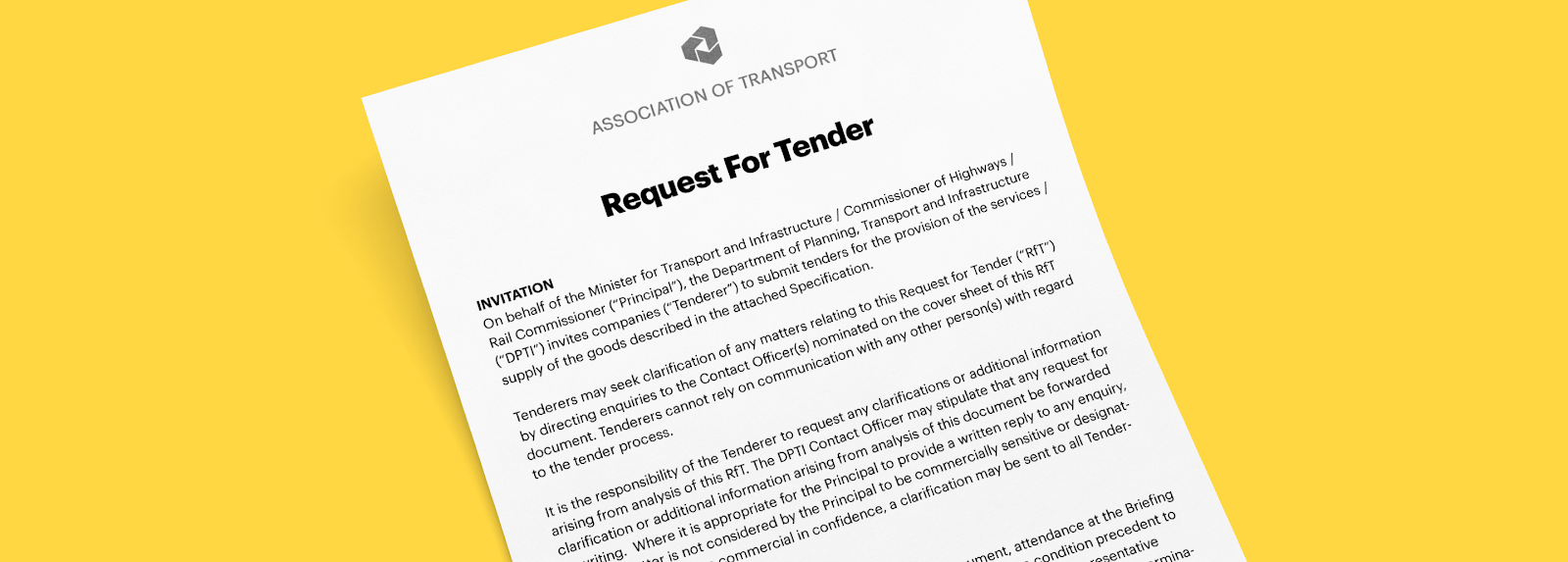April 29, 2019
 by Bethany Fagan / April 29, 2019
by Bethany Fagan / April 29, 2019

Writing a request for tender (RFT) ought to be one of the easiest parts of launching a project.
If you’re ready to start evaluating suppliers, odds are that you’ve already done most of the legwork. You’ve likely defined your goals and timelines, considered every legality, and have a clear budget in mind.
Yet, if you’re like most people faced with the prospect of crafting an RFT, you’re probably feeling a mix of uncertainty and hesitation. You might be worried about leaving out an important section or unsure about whether to include certain pieces of information. You might be wondering whether a more concise request for quotation (RFQ) or a more generic, early-stage request for information (RFI) is more appropriate.
If you’re faced with any of the issues described above, fear not. In this guide, we’ll tell you everything you need to know about writing a well-structured, fully-compliant, and easy-to-navigate RFT. We’ll also define key terms, cover best practices, and provide you with concrete examples.
The word “tender” refers to an offer from a vendor to provide a service or set of goods.
An RFT, or request for tender, is an open invitation to suppliers, asking them to send offers - usually as sealed bids - in a structured format.
In the public sector, where RFTs are most common, there are usually various rules dictating how they should be formatted and how responses should be evaluated. These rules usually demand impartiality, openness, and strict adherence to evaluation criteria, among others.
It’s common for organizations, both government and private, to post RFTs publicly, either on their own websites or third-party platforms (like Alibaba.com) which suppliers know about. Potential bidders regularly check these forums for new requests and respond to those that interest them.
Phew! That’s a lot of three-letter acronyms!
There's a lot of overlap between these terms, and it’s common for people to use them interchangeably. If you’re a little confused, don’t worry. Most people who see them for the first time feel the same.
Here’s a quick rundown of each:
One useful way of understanding an RFT is as a document that sits between a request for proposal, which is much broader in scope, and a request for quotation, which is highly specific. RFTs are usually quite detailed in terms of the definition and description of the work that is required, much more than RFPs but less than RFQs.
A request for information is a precursory request for general details about how a project might be undertaken. It’s normal to create a more detailed RFP, RFT, or RFQ after responses to an RFI have been evaluated. A response to an RFI is not binding in any way for vendors, and may only constitute an early expression of interest in a project.
It’s also important to note that the use of specific terms is often tied to particular industries. It’s common for certain private-sector sectors to use the term RFP to refer to both RFTs and RFQs. In the construction industries, the term RFQ is more common. “Request for tender” is a term that’s generally (but not always) encountered in the government sector.
A request for proposal is a document sent to suppliers (or made available on a public platform) requesting proposals for a project to be submitted. The RFP process is usually much less open than the request for tender process, as businesses may choose to send an RFP to a pre-selected list of vendors and are not restricted in forming their own evaluation process.
Tip: G2’s Team Buying Tool makes it easier to identify certain vendors that are the best fit for your job. Collaborate with your buying team to gather requirements, prioritize needs, create a vendor shortlist, and evaluate the vendor products – all in one place, all for free!
So, while they are similar documents, an RFP will follow a business proposal format that will not usually apply to RFTs. Similarly, responses to RFPs will differ from more generic proposals, such as grant proposals, because they will be structured according to precise guidelines.
An RFQ, or request for quotation, is similar to an RFP. The biggest difference is that RFQs are more specific and provide exact or near-exact pricing for a standard range of products. They are usually sent during the later stages of the sales cycle when a company is ready to buy. Some RFQs may even include instructions about how to write an invoice if a respondent is successful.
A request for tender should follow a very similar structure to a request for proposal. RFTs are more commonly created and used by the government or government-funded bodies and departments; however, there may be added legal strictures and guidelines that need to be followed. With that in mind, the eight-point structure below should be utilized in the context of the legal regulations specific to your area, if regulations are applicable.
The cover page for an RFT is the equivalent of a book cover for a novel. It doesn’t give any information beyond the client name, your company name, and a title, but it is a chance for you to look professional and entice potential suppliers.
This short introduction should provide the recipient with basic information, so they understand what the request is about. It sets the context for the remainder of the request. Introduce your organization, provide an outline of the project, and describe the kind of supplier you’re looking for. The key word here is brevity. The cover letter should only span a few paragraphs.
| TIP: How to Write a Cover Letter |
Explain who you are and where the project fits into your broader mission and activities. You can elaborate on the information about your organization that you included in the cover letter – your industry, customers, size, etc. – and provide more details about the scope of work.
This section is where you describe your project in detail. Provide a general outline of activities and goals along with a clear breakdown of the products and services you need. You should mention any relevant quality assurance requirements and legal standards. It’s also usually a good idea to include a specific timeline. Including plenty of information in this section will help suppliers structure a response that best meets your needs.
By providing evaluation criteria, you enable potential suppliers to write their response accordingly. It’s also important that suppliers understand you have an impartial set of criteria applied equally to all respondents. You may wish to include a timeline here, outlining when the different stages of the evaluation process will occur.
When giving instructions about how suppliers should respond, you should include either a form (which they can fill out) or numbered instructions. Be as specific as possible.
These might include terms and conditions, contingencies for cancellation, payment details, and so on.
Suppliers may need to get in touch for clarification or for further information. Include contact details (preferably to individual people rather than departments) for this very reason.
There are a few simple rules which, when followed, will dramatically improve the quality of your RFTs. Keep the following guidelines in mind when creating your RFT:
You should give specific and detailed instructions about how recipients should respond. Consider including a response form in your RFT.
Because RFTs are most commonly used in government or public-sector areas, there are often strict legal requirements regarding openness and impartiality. These should always be rigorously adhered to.
Smart apps, which enable businesses to create completely paperless workflows, can save significant amounts of time and resources while simultaneously improving open and acceptance rates for RFTs. Most proposal software solutions come with tracking tools, template and content libraries, and collaborative dashboards, among other features.
Just because you’re the one hiring doesn’t mean you can discard the needs of recipients. Remember, most vendors will have limited time. Don’t ask for unnecessary information, ensure that the response format is clear, and provide details about the evaluation and selection process so they can best tailor their proposal.
RFTs are absolutely essential documents. They enable you to reach, evaluate, and select the best suppliers for your projects. If your organization is like most others, you’ve likely relied on outdated and ineffective RFT-creation processes. And this can result in hundreds of wasted hours of staff time and the needless frittering away of resources.
| TIP: Check out 5 ways to increase the close rate of your proposal |
Improving the quality of your RFTs is all about addressing the processes you have in place for creating and managing them. Adherence to best practices, the use of new technology to create and track RFTs, and reliance on proven templates, are all necessary ingredients for a winning “RFT mix”.
Now, time to start working on that cover page…
Ready to improve the quality of all internal processes? Learn about the best free project management software tools in 2019.
Bethany is the content marketing manager at PandaDoc. When she's not writing new content or discovering a new distribution channel, her time is spent exploring her Brooklyn neighborhood with her husband and two French Bulldogs, Tater Tot and Pork Chop.
Thousands of proposals for government contracts are sent every day.
 by Bethany Fagan
by Bethany Fagan
The purpose of starting a business is to solve a problem.
 by Diksha Singh
by Diksha Singh
If there is one thread you can follow through every organization and use to track the health...
 by Dave Parks
by Dave Parks
Thousands of proposals for government contracts are sent every day.
 by Bethany Fagan
by Bethany Fagan
The purpose of starting a business is to solve a problem.
 by Diksha Singh
by Diksha Singh


